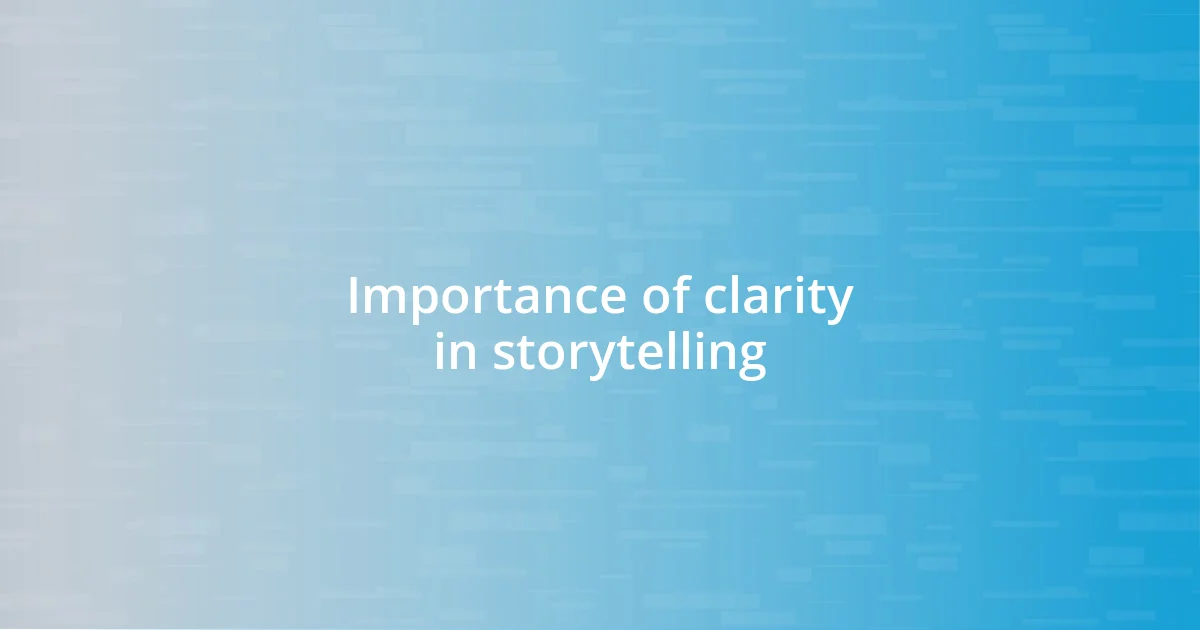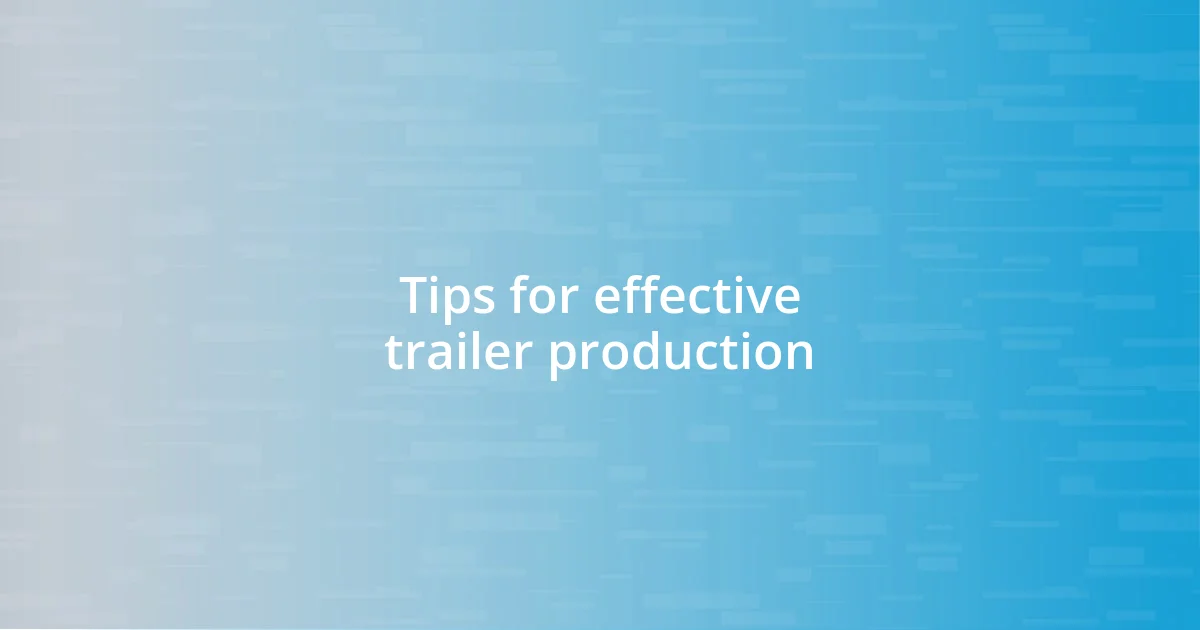Key takeaways:
- Effective trailers balance suspense and clarity through techniques such as pacing, music, and strategic silence to engage audiences emotionally.
- Clarity in storytelling is essential; a clear central theme helps viewers connect with characters and enhances their emotional investment.
- Successful trailers like “Inception” and “A Quiet Place” showcase the power of visual storytelling and sound design to create intrigue while maintaining essential narrative clarity.

Understanding suspense in trailers
Suspense in trailers is all about creating emotional tension that keeps the audience on the edge of their seats. I remember watching a trailer that employed a brilliant technique: it started with serene music and bright visuals, only to suddenly introduce a jarring sound that shook me out of that comfort. Isn’t it fascinating how sound and visuals work together to manipulate our emotions?
One key element of suspense is pacing. I often find that the deliberate slowing down of a scene—lingering on a character’s worried expression, for instance—can lead to a rush of anxiety as I wonder what might happen next. When I experienced this firsthand in a horror film trailer, I realized I was holding my breath, fully invested in the possible outcomes. How can something as simple as editing create such profound anticipation?
Transitions in a trailer can heighten mystery as well. For example, when I watched one trailer that seamlessly cut between various seemingly unrelated snippets, it left me questioning how they all intertwined. This feeling ignited my curiosity and made me eager to learn more. Don’t you think it’s intriguing how unresolved threads can compel us to seek answers?

Importance of clarity in storytelling
Clarity in storytelling forms the backbone of effective communication. I’ve often seen trailers that wrapped their narrative in so much mystique that I left feeling confused rather than intrigued. In one particular case, a trailer revealed stunning visuals but lost me entirely because I couldn’t grasp the main conflict. When I finally watched the film, I appreciated it more because I’d spent time piecing the story together; however, I couldn’t help but wish the trailer had given me just a little more clarity to hook me in right away.
- Clear narratives help audiences connect with the characters.
- They foster an emotional investment, making viewers care about the story.
- Clarity ensures key themes are understood, enhancing the overall impact.
- A straightforward plot can create anticipation without overwhelming the audience with ambiguity.
- Engaging clarity can lead to buzz and discussions even before the movie is released.

Techniques for creating suspense
Creating suspense is an art form that hinges on various techniques. One of my favorites is the use of music. I’ve noticed that a sudden change in score can elevate the tension dramatically. For example, remember that underrated thriller with the swelling strings followed by a sudden silence? That jarring shift made my heart race and left me questioning what was about to unfold.
Another technique I find compelling is the strategic use of silence. When a trailer includes a moment of complete quiet, it’s like an invitation for the audience to hold their breath. I recall experiencing this while watching a supernatural film trailer—there was a tense pause right before a shocking reveal, and I literally sat up in my seat, my pulse quickening as I braced for impact.
Finally, the manipulation of time can effectively build suspense. Flashing through scenes at rapid speed can spark curiosity, while slowing down pivotal moments can enhance the dread. I once viewed a trailer that frequently shifted between fast cuts and lingering shots, making me both anxious and intrigued. It’s intriguing how these editing choices can make the viewer feel both excitement and trepidation at the same time.
| Technique | Description |
|---|---|
| Use of Music | Creating emotional weight through changes in score, heightening tension. |
| Strategic Silence | Incorporating silence to build anticipation and create dramatic pauses. |
| Manipulation of Time | Employing fast cuts and slow-motion to evoke anxiety and curiosity. |

Strategies to maintain clarity
One effective strategy for maintaining clarity is to focus on a central theme or conflict that anchors the trailer. I recall working on a project where I highlighted a character’s struggle in the midst of chaos. This one-thread narrative made it easy for viewers to latch onto something familiar, even as other suspenseful elements danced around it. Wouldn’t you agree that it’s comforting to have a clear anchor amidst the fast-paced visuals?
Another approach is to strategically sequence the footage. For instance, I once analyzed a trailer that opened with a brief, impactful scene establishing the conflict before diving into the tension. This not only created a roadmap for the audience but also heightened their anticipation. I often think about how frustrating it can feel to get lost in a jumble of exciting clips—clarity cuts through that noise.
Finally, using concise and impactful dialogue can greatly enhance clarity. When I’ve queued short, poignant lines from characters, they have punctuated the visuals beautifully, allowing me to weave suspense without clouding the message. It makes the audience feel involved, as if they’re on this emotional journey rather than just a spectator. Have you ever noticed how a single line can resonate long after seeing a trailer? That’s the power of clarity at work.

Balancing suspense and clarity
Balancing suspense and clarity is a delicate dance, and I’ve found that it often requires careful thought in how information is presented. For instance, when I edited a trailer, I made a point to reveal just enough of the plot to intrigue viewers while leaving major twists and turns shrouded in mystery. It’s like offering a taste of a delicious dish—just enough to whet the appetite, but not so much that the entire meal is revealed. How satisfying is it to walk away with questions buzzing in your mind, eager for more?
In my experience, visual storytelling plays a vital role in achieving this balance. I remember crafting a trailer where a central character was painted initially in broad, mysterious strokes, creating suspense about their intentions. By juxtaposing this with moments of clarity—clear visuals of their personal world and struggles—I allowed the audience to connect emotionally. This setup anchored their intrigue, ensuring that viewers were invested and not lost in the suspense. Have you ever seen a trailer where the visuals left you both curious and informed? That’s the sweet spot we aim for.
Ultimately, editing techniques such as pacing and shot selection serve as my tools for maintaining this equilibrium. During one project, I experimented with varying the length of cuts to modulate tension while preserving context. Quick cuts built a sense of urgency, yet each frame revealed a hint about the story’s stakes. This method not only heightens the suspense but feeds the viewer’s need for clarity, making every second count. Isn’t it fascinating how the rhythm of a trailer can affect your emotional response? It’s moments like these that remind me why I love this craft.

Case studies of successful trailers
One standout example of a successful trailer that masterfully balances suspense and clarity is the teaser for “Inception.” I remember feeling my heart race as the trailer unfolded, cleverly revealing layers of intrigue while keeping the central plot under wraps. The visual metaphors—a city folding in on itself—grabbed my attention instantly, yet the brief glimpses of the characters’ dilemmas provided enough clarity for me to grasp the stakes. Hasn’t a trailer ever left you in a state of awe while still giving you just enough to piece things together?
Another excellent instance is the trailer for “A Quiet Place.” I recall how the silence echoed throughout the footage, creating an intense atmosphere of suspense. The way it opened with the quiet but chilling scene of the family in the woods immediately drew me in. Yet, as the tension built, snippets of their struggle for survival emerged plainly, helping me understand their circumstances. It’s truly mesmerizing how they used sound—or lack thereof—to convey a powerful story, making the audience acutely aware of both the suspense they faced and what they had to protect. Have you ever felt that deep connection to characters just from the tension of their world?
Lastly, “Get Out” offers another compelling case study. I distinctly remember the jarring shift from polite social interactions to an underlying sense of dread. The trailer maintains clarity by establishing the protagonist’s experiences while sprinkling in eerie visuals that hint at a far more disturbing reality. This mixture kept me on the edge of my seat, wanting to understand what was lurking beneath the surface. Isn’t it striking how a well-crafted trailer can leave you both anxious and curious, making you yearn to know more? That’s the magic of balancing suspense and clarity in a promotional piece.

Tips for effective trailer production
To create an effective trailer, one profound tip I’ve leaned on is to focus on a singular theme or emotion. I remember a project where I chose suspense as the central feeling. By weaving together visuals that echoed tension—like shadows and quick cuts—I was able to pull viewers into a gripping atmosphere. It’s like listening to a haunting melody that haunts you long after it ends—are you drawn in by what you can’t see, yet can feel?
Another strategy that has always paid off is utilizing strong, impactful dialogue. In one instance, I paired a gripping line from the film with evocative imagery, which instantly deepened the viewer’s understanding of the characters’ stakes. It struck me how a simple phrase could sparkle against the kinetic visuals, creating an anchor point for the audience. Have you ever caught yourself replaying a line from a trailer in your head? That’s the magic of well-placed words—they linger and resonate.
Lastly, I find that testing the trailer with fresh eyes is invaluable. Once, I screened a trailer with a diverse group of viewers to gauge their reactions. Their feedback revealed moments of confusion that I hadn’t caught. It drove home the necessity of clarity amid suspense. You wouldn’t believe how much insight those fresh perspectives can provide! Isn’t it incredible how collaboration can refine our creation into something that speaks universally, yet remains deeply personal?
















